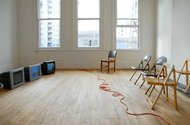John Hurrell – 20 March, 2009
You try to extricate meaning if you can, or wish to. You may not want to. You might prefer just letting the images and sounds wash over you - without analysing. To dissect though, you have to be really keen and believe the artist likes structure, has a focussed purpose.
Auckland
Tahi Moore
War Against the Self
13 March - 4 April 2009 (Gambia)
Against Other People
4 March - 21 March 2009 (A Centre for Art)
Lisa Stansbie
Hackamore
12 March - 10 April 2009 (Window)
These two Tahi Moore exhibitions show his passion for film and moving image in general. ‘Obsessed’ is too strong a word, but he really loves the stuff. No static images are here at all. The monitors function like chords and stacks of notes in a piece of music, clusters of ongoing movement and dialogue that weave in and out of each other’s field. Things are deliberately chaotic, though you can turn the sound down or up on each screen if you wish.
You try to extricate meaning if you can, or wish to. You may not want to. You might prefer just letting the images and sounds wash over you - without analysing. To dissect though, you have to be really keen and believe the artist likes structure, has a focussed purpose.
He certainly likes words, Moore does. He seems to love writing, and using friends for quoting and reciting. Included in the Gambia show with its five monitors are people repeating texts, some apparently written by a Chinese poet, Gu Cheng, who lived on Waiheke Island. And Moore includes as contrast tv clips of short story writer, novelist and poet Charles Bukowski telling stories. Bukowski talks exactly like he writes. Entertaining and vivid. Fast and gritty.
In this show (pictures above) Moore’s two titles from both Gambia and ACFA (they merge) are reflected in the array of screens competing for your attention while you try to focus mentally. There is even a text on the wall about sleep deprivation, implying (with irony I think) that the self (whatever that is) functions best when wide awake.
In the ACFA show we hear and see words too, in text running along the bottom of a monitor screen, from a book Martyn Reynolds is reading, or within a brief conversation he and Moore have about it. The ACFA show has four monitors.
Moore’s shows aren’t slick. They are rough hewn in the way he uses casual readings by friends, or home movies of individuals walking along a beach, or people in a flat dyeing fabric in a bath. These he places alongside Hollywood movies, a DiCaprio film that has been antiqued into black and white, or a Hitchcock silent, Lodger, blended with a later Bowie soundtrack of the same name.
So what is he up to with these installations? War Against the Self seems to be a meditation on the relationship between language and nature (somebody says ‘you have to live in the world and not in language…you could almost mistake this language for nature.’). It seems related to the work of Diane Thater but without her pop arty colours and big production. Moore loves found imagery and making juxtapositions.
Against Other People is more about the Word versus the Body, a very abstract approach to the physicality of thought, one that slides from the separation of dualism to the explicitly corporeal approach of Antonin Artaud. Thought ‘lodging’ in the body.
In contrast to Moore’s installations where you walk around the images straining to decipher the words, on the Window website is an intriguing work by the British artist Lisa Stansbie. If you click on you can see and hear where she has treated three sections of film by adding carefully written audio ‘commentaries’ that only tangentially connect with the ‘action’. You sit in front of your computer at home and concentrate on the three clips one at a time. Even without connecting the disparate narratives and voiceovers - the three ‘club sandwiches’ - on a sensual level, the sound, the language manipulation, and the visual images are remarkable. Unlike Moore’s monitors, they don’t overlap. If you wish, you can do that in your head anyway.
- John Hurrell






 Advertising in this column
Advertising in this column Two Rooms presents a program of residencies and projects
Two Rooms presents a program of residencies and projects



This Discussion has 0 comments.
Comment
Participate
Register to Participate.
Sign in
Sign in to an existing account.